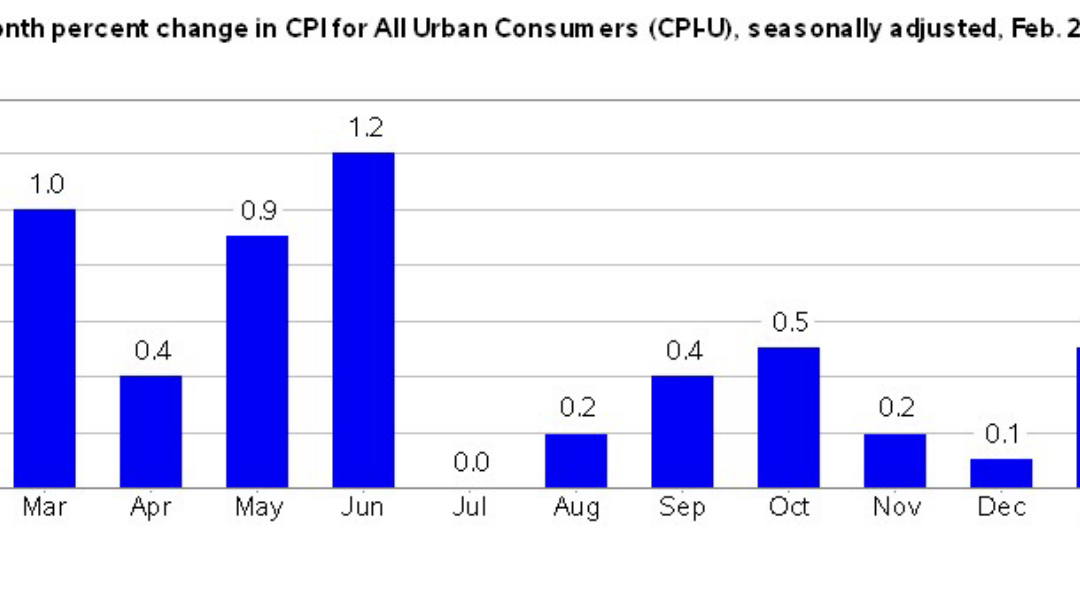
by Liam Hunt | Mar 14, 2023 | Monthly CPI Updates
The Consumer Price Index for All Urban Consumers (CPI-U) increased by 0.4% on a seasonally adjusted basis, per the Bureau of Labor Statistics. Year-over-year, before seasonal adjustment the all items index grew by 6.0%, which is down from 6.4% in January.
According to CNBC, the biggest culprits driving inflation this month were eggs (+55.4%), butter and margarine (26.9%), and airfare (26.5%). The greatest counterweights were televisions (-14.8%) and used cars and trucks (-13.6%), which both cooled down considerably.
February’s CPI data continues a general deceleration of inflation that has been ongoing for several months, and which represents a considerable cooling off from the pandemic-era peak of 9.1% in June 2022. Prior forecasts pegged February’s seasonally adjusted CPI to come in at 6.0%, which turned out to be exactly on the money. However, core CPI came in a little hotter than expected, by precisely one-tenth of one percent at 0.4% (5.5% year-on-year).
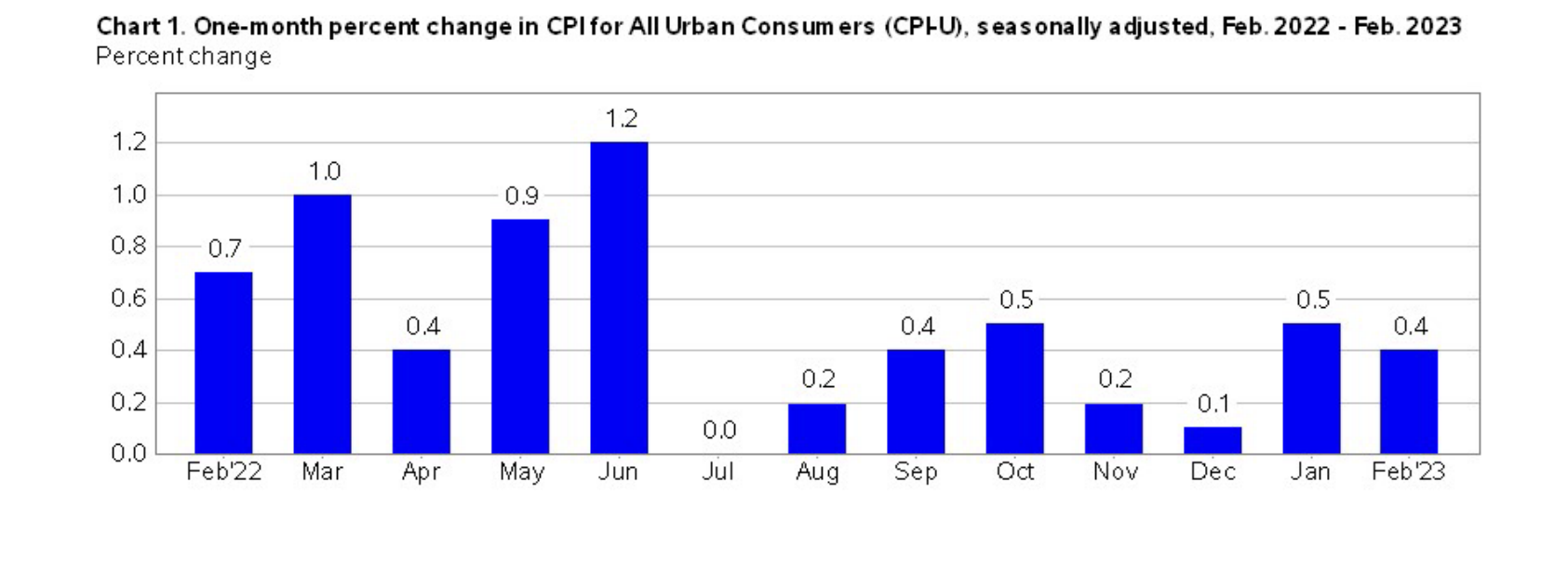
Source: U.S. Bureau of Labor Statistics
Food
In February, the food index rose by +0.4% while the food at home index rose at a slightly lesser pace of +0.3%. Compared to January, five out of six food categories increased, including nonalcoholic beverages and dairy and related products.
On the other hand, certain food categories fell, including poultry, fish, and eggs, which decreased (-0.1%) in February, which constitutes the first decrease in this food category in 14 months (December 2021).
Energy
When it comes to energy prices, the energy index fell (-0.6%) in February, following a fairly large 2.0 percent increase in January. Bringing the CPI-U down was the natural gas index, which dropped by the largest margin since 2006 (-8.0%).
Over the past 12-month period, the energy index hiked +5.2%, whereas the fuel oil index rose +9.2% in the same period alongside electricity at +12.9% and natural gas at +14.3%.
Gasoline costs fell (-2.0%) in February, providing much-needed price relief at the pump for American consumers.
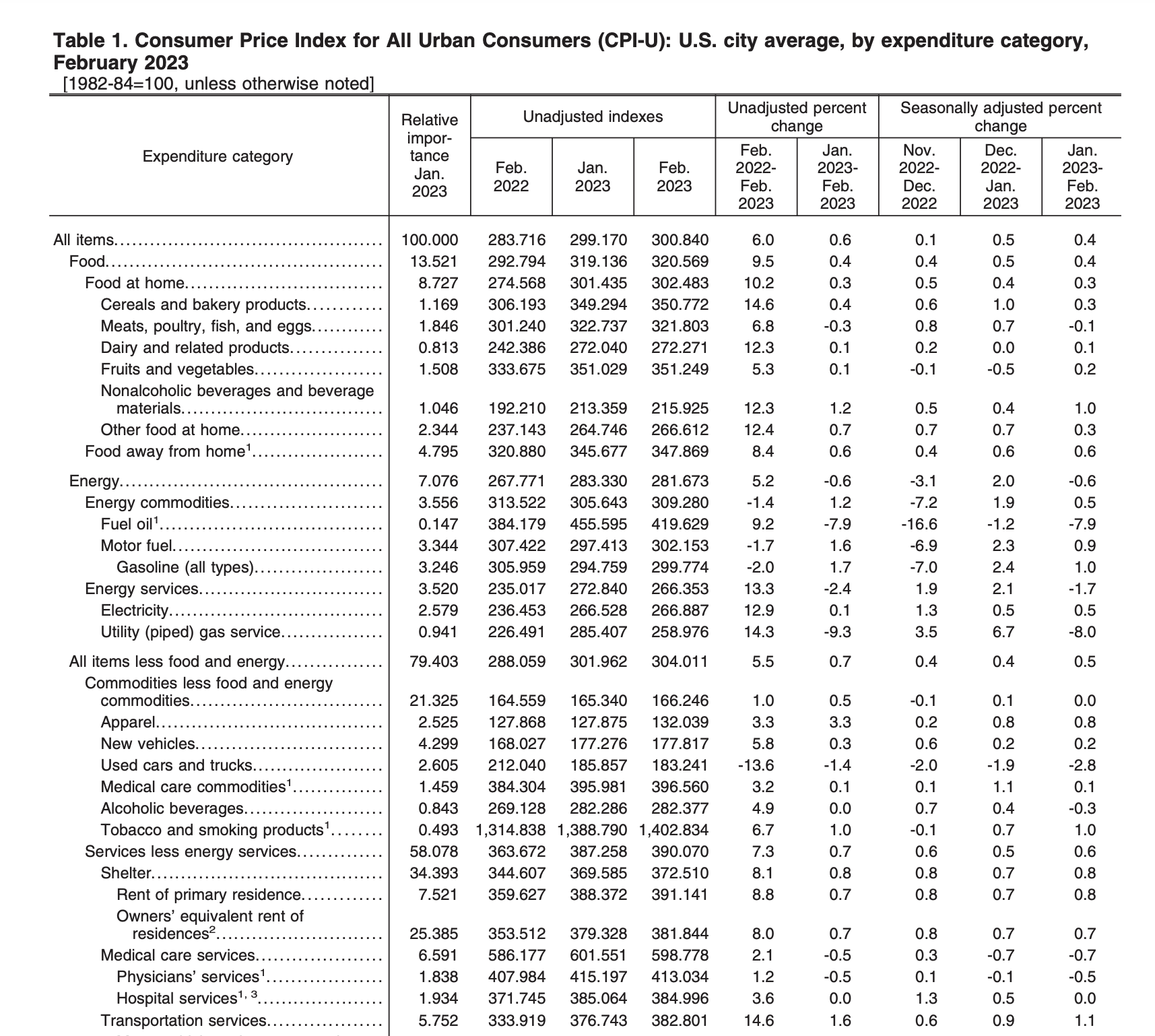
Source: U.S. Bureau of Labor Statistics
All Items Less Food and Energy (February 2023 Core CPI)
February 2023’s core CPI came in at 0.5%, which represents a slight increase over many market watchers’ expectations of 0.4% and constituting a rise from 0.4% in January. Driving up the core CPI was the shelter index, which rose 0.8% and the index for rent which went up 0.8% as well. Lodging away from home rose by 2.3% in February.
Within the core CPI, the shelter index was the greatest driver of the index’ larger-than-anticipated outcome in February. Additional upward pressures were asserted by prices for motor vehicle insurance by +14.5% and household furnishings at +6.1%. However, numerous areas within the core index fell, including the medical care index (-0.5%) and the index for physicians’ services (-0.5%).
Inflation Matches Expectations in February: Interest Rate Relief to Come?
Given that February’s CPI report matched analysts’ expectations, we may see Federal Reserve Chairman Jerome Powell announce a temporary off-ramp of the central bank’s quantitative tightening policy. As speculated on CNBC Television on Tuesday, the current crisis at Silicon Valley Bank, with the threat of a contagion spilling over into over sectors of the U.S. and global economy, it may be in the Fed’s best interest to pause rate hikes following the next Federal Open Market Committee meeting on March 21 and 22.
In short, February’s report indicates that the Fed’s hawkish interest rate policy, which has seen multiple .25 and .50 basis point hikes as of late, has been largely successful in restraining inflation. This month’s CPI came in exactly where experts predicted they would, with the slight exception of the core CPI which was only a bit hotter than anticipated. Given the ongoing systemic problems in the lending market, we may, however, see the Fed’s interest rate policy relaxed through the spring, which may temporarily give rise to a new rebound period in the inflation rate.
Curious about how inflation is impacting your retirement and the economy at large? Check out our calculator widget to see how the CPI is affecting your financial freedom, and don’t forget to subscribe to our monthly newsletter if you haven’t already—this way, you can stay abreast of the latest CPI developments as soon as they’re released.
Source Cited: https://www.bls.gov/news.release/cpi.nr0.htm
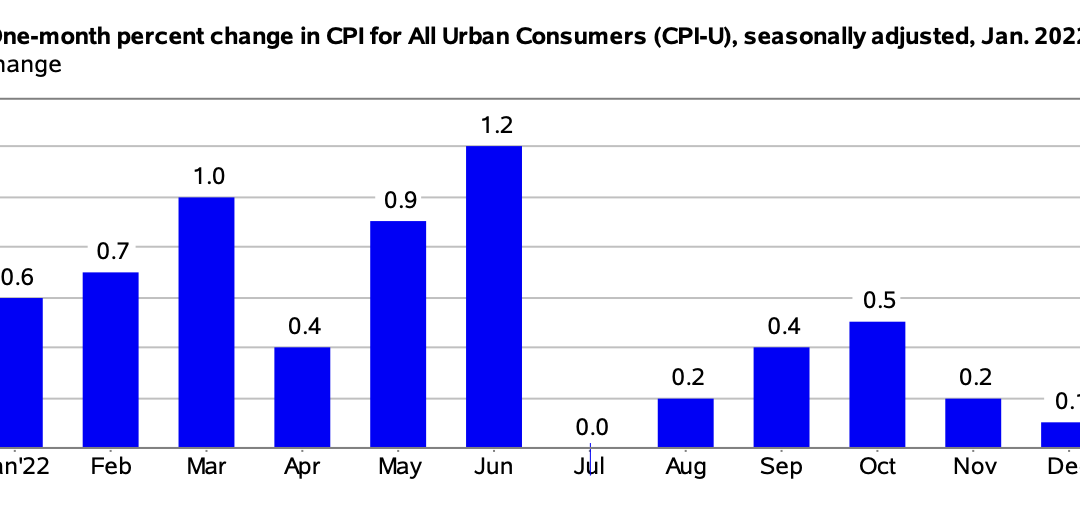
by Liam Hunt | Feb 14, 2023 | Monthly CPI Updates
The Consumer Price Index for All Urban Consumers (CPI-U) increased by 0.5% on a seasonally adjusted basis, reported the Bureau of Labor Statistics. Year-over-year, before seasonal adjustment the all items index grew by 6.4%.
The primary contributing variable to the acceleration in the CPI-U was shelter, but other items such as food, gasoline, and home heating costs also applied upward pressure on the CPI-U.
Even though they represented a modest easing in inflation, January’s CPI figures, on the whole, came in slightly worse than analysts expected. For example, Bloomberg forecasted a deceleration to 6.2%—a whole 0.2 points below the actual figure.

Source: U.S. Bureau of Labor Statistics
Food
In January, the index for food rose by 0.5%, following a 0.4% rise in December 2022. Of the six major grocery store indices utilized by the BLS, four of them increased month-over-month. Meats, poultry, fish, and eggs increased by 0.7% in January while the egg cost index increased 8.5%.
By contrast, fresh fruits and vegetables lowered in price in January, falling 0.5%, while dairy prices remained the same as in December 2022.
Gasoline Prices
January’s gasoline prices increased 2.4% month-over-month. Before seasonally adjusting, the price at the pump rose by 3.2%. Therefore, consumers paid considerably more to fill their car’s gas tank in January compared to the month prior.
Energy
The energy index rose 2.0% in January and 8.7% year-over-year, representing a stark increase due in large part to the ongoing Russian invasion of Ukraine. Over the past 12-month period, the fuel oil index rose 27.7% while electricity costs rose 11.9% and natural gas rose 26.7%.

Source: U.S. Bureau of Labor Statistics
All Items Less Food and Energy
January 2023’s CPI report indicated that the core index (i.e., less food and energy) rose 0.4%. Main contributors to the rise in the core index were shelter costs, motor vehicle insurance, recreational costs, clothing and apparel, and household furniture and goods. Those that decreased, by contrasted, were used cars and trucks, healthcare costs, and airfare.
The shelter index was the single strongest factor in January’s rise in the core CPI. The shelter index alone rose 7.9% compared to last year, which was responsible for roughly 60% of the total upward pressure on January 2023’s CPI less food and energy.
In sum, while continuing a multi-month downtrend in overall inflation, January 2023’s CPI report was higher than many market watchers expected.
Want to learn more about how inflation is impacting the economy? Take a look at our calculator widget to keep tabs on how the CPI is impacting your financial life, and don’t forget to subscribe to our monthly newsletter if you haven’t already.
Source Cited: https://www.bls.gov/news.release/cpi.nr0.htm
by Emily Cross Leon | Nov 17, 2015 | In the news, Inflation, Monthly CPI Updates
The BLS released October’s inflation data this morning and there were no major surprises. The Consumer Price Index for All Urban Consumers (CPI-U) climbed a seasonally adjusted 0.2% in October following a decline of 0.2% in September. This is in line with consensus expectations. Year over year, the CPI-U was up 0.2% at the end of October, which is well below the Fed’s annual inflation target rate of 2%. According to a recent Federal Reserve press release:
“Inflation has continued to run below the Committee’s longer-run objective, partly reflecting declines in energy prices and in prices of non-energy imports.”
Core inflation, which excludes food and energy, increased 0.2% in October, following a 0.2% increase in September. For the year ending in October, core inflation was 1.9%. Outside of the volatile energy index, which was down over 17% for the 12-months ending in October, consumer prices appear to be climbing at a steady pace only marginally below the Fed’s target.

October’s Seasonally Adjusted Inflation
October’s 0.2% climb in consumer prices was largely driven by modest increases in the energy index, which rose 0.3% following a decline of 4.7% in September. Gas prices were up 0.4% in October compared to a 9% decline in September (this still leaves gas prices down 27.8% year over year).
A 0.8% spike in the index for medical care services also helped drive October’s inflation. This includes a significant jump in the hospital services index, up 2% in October. Overall, medical care costs posted a 0.7% gain in October including a 2.3% jump in the costs of inpatient services and a 1.7% rise in the costs of outpatient services.
Four of the six major grocery store food groups saw prices rise in October. The overall food index rose a modest 0.1%, following a 0.4% rise in September. The price of fruits and vegetables climbed 0.5% in October, while the index for meat, poultry, fish and eggs fell by the same amount, despite a 3.4% increase in the cost of bacon and bacon related products. A fall of 4.8% in the price of eggs was particularly notable for the month. Breakfast cereal and butter posted strong price gains, rising 2.4% and 5.3% in October.
Shelter costs continued to climb steadily, up 0.3% in October, matching Septembers change. Shelter costs have risen between 0.2% and 0.4% every month this year. The index for lodging away from home, up 0.8% in October, contributed significantly to higher shelter costs, .
The apparel index was down 0.8% in October. There was a large amount of variation within the index. The index for boys apparel climbed 2.9% while the index for girls apparel fell by 2.9%. Delivery services also fell in October, down 2%.
Seasonally Adjusted Monthly % Change in CPI-U by Category (2016)
| January | February | March | April | May | June | July |
| All Items | 0 | -0.2 | 0.1 | 0.4 | 0.2 | 0.2 | 0.0 |
| Food | 0 | 0.2 | -0.2 | 0.2 | -0.2 | -0.1 | 0.0 |
| Energy | -2.8 | -6.0 | 0.9 | 3.4 | 1.2 | 1.3 | -1.6 |
| Gasoline | -4.8 | -12.5 | 2.2 | 8.1 | 2.3 | 3.3 | -4.7 |
| Fuel Oil (non seasonally adjusted) | -6.5 | -2.9 | 1.7 | 1.9 | 6.2 | 3.7 | -1.5 |
| Electricity | -0.7 | -0.2 | 0.4 | -0.3 | -0.2 | -0.5 | 0.5 |
| Utilities (piped gas service) | -0.6 | 1.0 | -0.7 | 0.6 | 1.7 | -0.4 | 3.1 |
| Energy Services | -0.7 | 0.1 | 0.2 | -0.1 | 0.2 | -0.5 | 1.0 |
| All Items Less Food and Energy | 0.3 | 0.3 | 0.1 | 0.2 | 0.2 | 0.2 | 0.1 |
| Services Less Energy Services | 0.3 | 0.3 | 0.2 | 0.3 | 0.4 | 0.3 | 0.2 |
| Shelter | 0.3 | 0.3 | 0.2 | 0.3 | 0.4 | 0.3 | 0.2 |
| Transportation Services | 0.4 | 0.2 | 0.2 | 0.7 | 0.3 | 0.3 | -0.2 |
| Medical Care Services | 0.5 | 0.5 | 0.1 | 0.3 | 0.5 | 0.2 | 0.5 |
12-Month Inflation
For the 12-months ending in October, unadjusted inflation was 0.2%. This includes a 27.8% decline in the index for energy commodities, which accounts for roughly 3.8% of the total CPI-U. The overall energy index fell 17.1% for the year. Despite the strong negative impact of energy prices, the CPI-U is marginally higher for the year.
Food prices, which account for over 14% of the overall price index, were up 1.6% year over year. Annual changes in food prices were mixed. Eggs were 30% more expensive than they were one year earlier. Over the same period, milk became 7.5% cheaper and the index for salt and seasoning rose 7.0%. Food at employee sites and schools was 5% higher for the year.
The prices of many consumer goods became cheaper over the year. The indexes for apparel and for appliances posted 1.9% and 4% declines respectively. The price of a television set has fallen 13.3% year over year, while the index for toys was down 6%. On the other hand, the cost of shelter rose 3.2% for the year with moving costs up 6.4%.
Outlook for the Fed
Most economists expect the Fed to raise interest rates in December, which would be the first rate hike in over 9 years. Today’s inflation release should not have a significant impact on these expectations. Fed fund futures are pricing in a 73.6% likelihood of a 0.25% rate hike on December 16th, which would bring the Fed Funds rate to 0.5%. The level of uncertainty around this highly anticipated hike and the pace of tightening over the coming years is unprecedented.
The modest but steady growth in the U.S. economy is in stark contrast to slowdowns in much of the world. With the EU considering quantitative easing and Japan dipping into recession, international money is flowing into the U.S. economy, driving the dollar higher. A rate hike would put further upward pressure on the U.S. dollar, which would create a slowdown in domestic manufacturing. It would also make imports cheaper, potentially keeping inflation from moving towards the target rate. The graph below shows the U.S. dollar reaching its highest level in 10 years versus a basket of international currencies. This should be a major concern at the next FOMC meeting on December 15th and 16th.
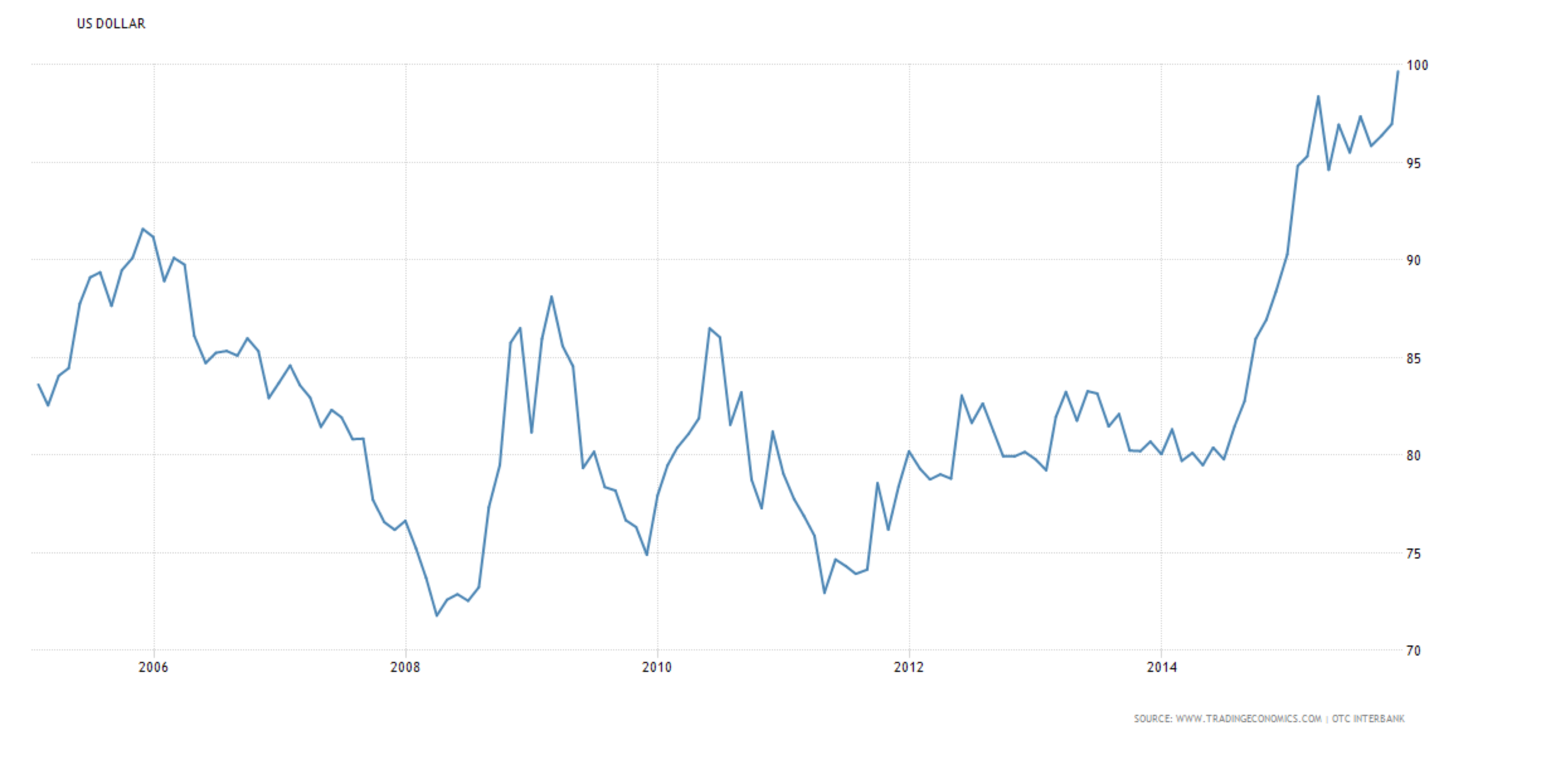
by Emily Cross Leon | Oct 15, 2015 | In the news, Inflation, Monthly CPI Updates
Falling gas prices kept inflation below zero for the month of August. The BLS announced this morning that the Consumer Price Index for All Urban Consumers (CPI-U) fell 0.2% in September on a seasonally adjusted basis; this is in line with expectations. In August, the CPI-U fell 0.1% following 6 straight months of growth. Gas prices also drove the decline in August’s CPI-U number. September’s decline wiped out the annual gains of 0.2% that were posted at the end of August, leaving the CPI-U flat for the year ending in September.

The index for all items less food and energy was up 0.2% in September, following increases of 0.1% in both July and August. For the 12-months ending in September, this core index increased 1.9%, pointing to more robust underlying growth for the U.S. economy. This is the highest annual core inflation number since July 2014. As the graph above shows, the disparity between overall consumer prices and consumer prices less food and energy continues to grow.
Energy Prices
The decline in overall consumer prices in September was largely driven by falling gasoline prices, which were down a seasonally adjusted 9% in the month alone. Over the same period, the energy index fell 4.7%, adding to August’s 2% decline. The energy index accounts for about 8% of the CPI-U and gasoline about 4%.
Volatile gasoline and energy prices have driven overall price levels and kept inflation very low over the past year. The energy index is down 9.7% for the year ending in September. Over this period, the biggest price declines were seen in the price of gasoline and fuel oil, down 18% and 18.6% respectively.
Seasonally Adjusted Monthly Numbers
On a seasonally adjusted basis, the CPI fell 0.2% in September following a decline of 0.1% in August.
Seasonally Adjusted Monthly % Change in CPI-U by Category (2016)
| January | February | March | April | May | June | July |
| All Items | 0 | -0.2 | 0.1 | 0.4 | 0.2 | 0.2 | 0.0 |
| Food | 0 | 0.2 | -0.2 | 0.2 | -0.2 | -0.1 | 0.0 |
| Energy | -2.8 | -6.0 | 0.9 | 3.4 | 1.2 | 1.3 | -1.6 |
| Gasoline | -4.8 | -12.5 | 2.2 | 8.1 | 2.3 | 3.3 | -4.7 |
| Fuel Oil (non seasonally adjusted) | -6.5 | -2.9 | 1.7 | 1.9 | 6.2 | 3.7 | -1.5 |
| Electricity | -0.7 | -0.2 | 0.4 | -0.3 | -0.2 | -0.5 | 0.5 |
| Utilities (piped gas service) | -0.6 | 1.0 | -0.7 | 0.6 | 1.7 | -0.4 | 3.1 |
| Energy Services | -0.7 | 0.1 | 0.2 | -0.1 | 0.2 | -0.5 | 1.0 |
| All Items Less Food and Energy | 0.3 | 0.3 | 0.1 | 0.2 | 0.2 | 0.2 | 0.1 |
| Services Less Energy Services | 0.3 | 0.3 | 0.2 | 0.3 | 0.4 | 0.3 | 0.2 |
| Shelter | 0.3 | 0.3 | 0.2 | 0.3 | 0.4 | 0.3 | 0.2 |
| Transportation Services | 0.4 | 0.2 | 0.2 | 0.7 | 0.3 | 0.3 | -0.2 |
| Medical Care Services | 0.5 | 0.5 | 0.1 | 0.3 | 0.5 | 0.2 | 0.5 |
The price of food climbed 0.4% in September, adding to August’s 0.2% increase in the food index. Higher prices for dairy and fruits and vegetables, including a 4.7% spike in the price of lettuce, were somewhat offset by declines in the prices for fish and poultry. The index that measures the price of food in primary and secondary schools was 7.2% higher in September alone.
The shelter index continues to climb, up 0.3% in September, following increases of between 0.2% and 0.4% per month since the beginning of the year. In September, higher shelter costs were the result of higher prices for hotels and lodging away from home. The rent index, which is part of the shelter index, climbed 0.4% in September. Shelter costs account for about one third of the CPI-U.
The medical care index was up 0.2% in September, including increases of 0.3% for medical care services and 0.6% for health insurance. At the same time, the costs for both prescription drugs and medical equipment and supplies were down 0.2%.
Following four months of declines, the index for household furnishings and operations increased 0.4% in September despite a fall of 0.7% in the price of floor coverings. Indoor plants and flowers were significantly more expensive, gaining 2.4% in September.
The index for apparel fell 0.3% in September, following two months of gains. September’s apparel number masks volatility within the index. On a seasonally adjusted basis, the prices for men’s outerwear fell 3.9% and girl’s apparel was down 3.7%. At the same time, the price of men’s sweaters climbed 8.7%.
Annual Inflation
September’s declining CPI-U wiped out any 12-month gains, leaving overall price levels flat for the year. Higher prices for most components of the index were just able to balance the 12-month 18.4% decline in energy prices. The food index was 1.6% higher for the 12-month period and Shelter costs climbed 3.7%. Transportation services were 2.2% higher, including increases of over 5% for both car and truck rentals and vehicle insurance. Significant 12-month price hikes were also posted for animal services including veterinary services (up 4.3%), admission to sporting events (up 7.8%) and childcare and nursery school fees (up 4.2%). In general, higher prices were recorded for most services. Financial service costs were nearly 4% higher for the year, including an increase of 5.1% for tax and accounting services.
Price declines over the past year include the cost of cell phone services (down 3.8%) and the index for cell phone hardware, calculators and consumer information items, which tumbled 15.8%. Airline fares were down 6% for the year as was the price of toys. Television sets became over 13% less expensive compared to a year earlier and the price of appliances in general fell 3.5%.
Economic Outlook
Today’s inflation numbers will be watched closely as the Federal Reserve appears divided over the possibility of an interest rate hike later in the year. Stronger inflation numbers would have suggested that the economy was more robust and ready for higher interest rates. However, today’s weak inflation data, although expected, add to a series of disappointing indicators.
The Producer Price Index, a principal gauge of inflation in the manufacturing sector, declined by 0.5% in September, its weakest number in 7 months. September retails sales were also a disappointment, missing expectations at 0.1% versus the expected 0.2%. Core retail sales slipped 0.3% below the expected decline of 0.1%. The U.S. dollar has also been falling due to a disappointing .
The next Federal Open Market Committee meeting is October 27-28. The markets have been pricing in approximately a 39% chance of a rate hike in December. However, this number has been declining following downturns in global and emerging markets. Today’s CPI-U numbers will not reverse the trend. Rates are likely to remain unchanged until at least March of next year.
by Andrew | Jul 17, 2015 | BLS, CPI, Definitions, In the news, Inflation, Monthly CPI Updates
U.S. consumer prices increased for the fifth consecutive month in June, led higher by a rebounding price of gasoline, although there was nothing in the latest release which should pose any immediate alarm for markets or consumers at large. The latest report from the BLS reported an overall increase in headline inflation of 0.3% month on month – an increase that was inline with nearly all economists polled prior to the announcement. Looking at the headline number on an annualized basis, inflation rose 0.1 percent In the 12 months through June, following an unchanged reading for the month of May.
Gasoline prices rose 3.4% month on month, following a 10.4 percent surge in May. Given the recent volatility in crude oil prices and inventory data in July, there could be scope for the influence of rising gas prices to subside in coming months. Oil is currently trading within the $50-60 / bbl range, well below the levels seen in May and June.
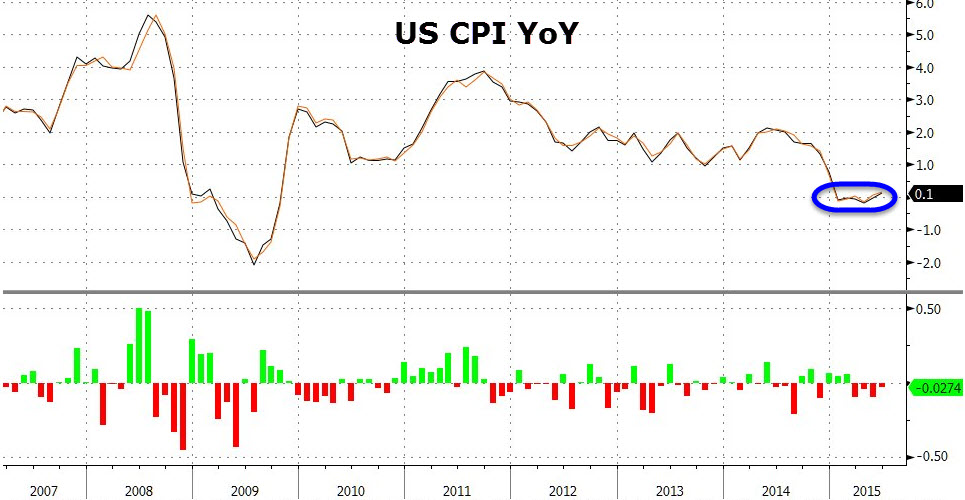
Core CPI, which excludes food and energy related costs, increased 0.2 percent month on month following a rise of 0.1% previously. On an annualized basis, core CPI has now risen 1.8 percent.The June reading continues to highlight just how tame the inflationary environment is within the US economy at present. The strong dollar is helping to keep a lid on inflation by reducing the price of imports and wholesale costs. The strong US dollar has been been spurred partly by a flight to safety due to concerns in Europe and China, and partly by the market’s anticipation of a Fed rate hike later this year. We should expect to start hearing comments regarding the damaging effects of the stronger dollar by Fed officials in the weeks and months ahead should this trend continue.
The food index posts largest increase since September 2014
The price of food increased 0.3% in June, largely to an ongoing shortage in wholesale eggs which has caused a sharp jump in retail egg prices across the nation. Egg prices jumped 18.3% in June, the largest monthly gain since August 1973. Elsewhere, the index for meats, poultry, fish, and eggs rose 1.4 percent in June, with the beef index rising 0.9 percent. Food prices are likely to remain elevated in the coming months as the aftermath of the bird flu epidemic works its way through the supply chain. Wholesale food costs have been consistently increasing in PPI surveys, and these costs are likely to make their way down to the consumer in the weeks and months ahead.
Medical Price Inflation starting to cool off
Medical related inflation cooled in June which will be a welcome deviation from the overall trend in 2015. The price for Medical Care Services fell -0.2% in June and the prices for Medical Care Commodities remained unchanged month on month. Health care costs have been one of the largest contributors to inflation over the past 12 months, with both indices rising 2.3 percent and 3.3 percent respectively.
Rent Prices continue to Climb Higher
The shelter index climbed 0.3% in June, and 3% on an annualized basis as the supply of housing continues to shrink in key regions. Rent increases are also amongst the largest contributors to overall inflation in the United States within the past 12 months.
Outlook for Rates
This month’s CPI data contains no surprises, and the relatively tame reading in the core number on the back of the strong US dollar will likely stick in the minds of Fed officials in the weeks ahead. Globally, sentiment continues to wane dramatically given the continued turmoil in Greece, and increasingly China. While Greece appears to be on the verge of some sort of political settlement, the headline risk remains. In China’s case, there is a very real danger of investor sentiment turning, which could spell disaster for emerging markets overall. Latin American and South East Asian markets look at particular risk, especially on the currency front. The fate of these regions would be sealed in no uncertain terms should the Fed raise rates, and it is for this reason that it appears increasingly unlikely that the Fed will raise by year end, despite all of their rhetoric and expressed intention to do so.











